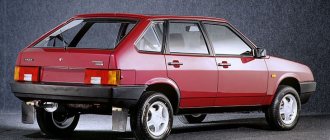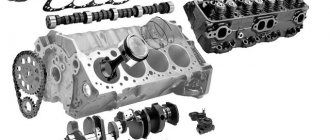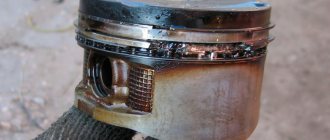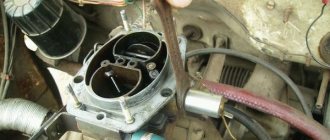What year did the injection VAZ 2109 start?
The VAZ 2109 injection engine is not new. Since 1994, such units have been installed on cars of the Lada family. As you know, there have always been supporters and opponents of both carburetor and injection options. On the VAZ 2109, injection engine starting means less harmful emissions into the environment, better dynamics at high speeds and much more. From this publication you will learn not only the difference between both types of engine, but also receive valuable tips on how to change a carburetor unit to an injection unit with your own hands. So, both units have more than enough advantages. Before choosing which engine to choose for your “nine”, it is recommended to decide in what mode the car is operated most of the time. All this is of considerable importance.
Carburetor engine for VAZ 2109
VAZ 2109 injection engines
What can I say. Until now, many people respect this type of engine, despite its obsolescence. As you know, such engines are not installed on production cars today, but there are quite a few examples on the roads with a carburetor unit.
Note. Carburetor versions of engines have long received a scolding in developed countries. In Europe, where ecology and clean air are of great importance, such engines have long been blacklisted.
In principle, the large emission of harmful substances into the atmosphere is the first and most important disadvantage of such engines. Other features of this motor include the following:
Note. In particular, at high speeds it is more difficult for a VAZ 2109 with a carburetor power unit to overtake, due to the fact that the car’s throttle response is significantly reduced. On the other hand, when starting from a standstill, such an engine allows you to increase the required speed very quickly (14 or 16 s/100 km/h).
VAZ 2109 injection engine
Note. Some VAZ 2109 models with a carburetor unit, released recently, even had automatic control of this damper.
Such an engine, of course, also has its advantages:
Note. One of the options for quick carburetor repair involves purging, when two armored pipes are swapped. But with an injection engine this will definitely not be possible.
Conversion of carburetor to injector VAZ 2109
First you need to choose a good injection system for the VAZ 2109. Bosch M 1.5.4 is perfect for installation due to its reasonable cost. We installed the injection system without additional upgrades or improvements. This is better than installing an external fuel pump and purchasing additional parts from General Motors.
It is more correct to buy parts that have already been time-tested and are used on production cars, including:
Various bolts, clamps and other consumables are not a problem to purchase at any store.
Tank replacement
Before disassembling the carburetor system, wash and dry the new gas tank and install an electric fuel pump. Remember that the arrows on them must match in both places. Make sure that the float of the sensor indicating the fuel level in the gas tank.
Holes for mounting the module and sensor
Next, you need to make a hole in the cylinder block for mounting a bracket designed for an ignition module with a depth of 20 mm, and another one for the knock sensor (16 mm). To do this, drain the antifreeze and remove the radiator along with the bumper.
Sometimes such holes can be made at the factory. If they are not there, then special grooves are provided for the module and sensor. Be careful not to drill through the block! If in doubt, let a master do it for you.
Cooling, generator
Among other things, you need to install a new coolant pipe, and change the temperature sensor in the radiator. After this, you need to drain the oil and remove the pan from there, remove the toothed pulley and belt, and install a special generator damping pulley instead of the standard one.
Then it is necessary to install a new generator, since the new system requires more voltage than usual. Here you can’t get by with just a regular pulley replacement. We need to install a new generator in our VAZ 2109 - this is a must. Otherwise, the generator will simply become unusable.
Carburetor. Advantages and disadvantages
Let's start with the negative points. These include:
Nine carburetor
But let's not just talk about the bad. The VAZ 2109 with a carburetor also has positive qualities:
Swapping a couple of armored pipes and doing a purge is a simple option for quickly repairing a carburetor yourself. The injection engine does not understand such tricks.
Article on the topic: Features of replacing the rear brake cylinder 2114
Injector. Advantages and disadvantages
In short, all the advantages of the injector are the disadvantages of the carburetor, and all the disadvantages are the advantages of the carburetor.
Injection nine
The key features of injection engines include:
Converting a carburetor to an injector
VAZ 21093 injection engines
This can be done. As promised, we provide instructions. The alteration can be carried out in your own garage, preferably with an assistant.
An object
The object of modification can be not only the VAZ 2109, but also the G8, as well as the VAZ 21099 (cars with carburetor engines). The goal and objective of the operation: to convert the unit into a 16-valve injector by installing a cylinder head from a VAZ 2112. Already at the stage of completing the conversion, without even adjusting the ECU, a big difference is felt. The dynamics of the car increases, the car behaves differently on the highway, and gas consumption decreases. On the other hand, the car's performance deteriorates at low speeds, but they are compensated by improved traction at high speeds (after 2000 rpm).
Note. Any owner of a “nine” will be glad that now his car will show the same acceleration in 4th speed as in the past in 3rd. If only the road is straight, then the “injector” will show itself and easily reach the level of 5000 rpm.
Preparation
The operation, of course, requires proper preparation. The following components should be, as they say, at hand:
cylinder head VAZ 2112
Engine power VAZ 21099 injector
Information must be verifiable, otherwise it may be questioned and deleted. You may edit this article to include links to authoritative sources. This mark was set on November 20, 2014
VAZ-21099 “Sputnik” on Wikimedia Commons
| Manufacturer | AvtoVAZ |
| Years of production | 1990-2004 - in Russia 2004-2011 - in Ukraine |
| Assembly | VAZ (Togliatti, USSR) AvtoVAZ (Tolyatti, Russia) RosLada (Syzran, Russia) ZAZ (Zaporozhye, Ukraine) Anto-Rus (Kherson, Ukraine) |
| Other designations | Lada Forma, Lada Sagona, Lada Diva, Lada Sable, Lada Samara Saloon, Lada Samara, Lada Sputnik |
| Body type(s) | 4-door sedan (5-seater) |
| Layout | front engine, front wheel drive |
| Wheel formula | 4 × 2 |
| Length | 4205 mm |
| Width | 1650 mm |
| Height | 1402 mm |
| Clearance | 170 mm |
| Wheelbase | 2460 mm |
| Rear track | 1370 mm |
| Front track | 1400 mm |
| Weight | 950 kg |
| Successor Successor VAZ-2115 |
| Related | VAZ-2108 VAZ-2109 |
| Segment | B-segment |
| Load capacity | 475 kg |
| Fuel consumption | 5.9-8.9 l/100 km |
| Volume of the tank | 43 l |
Rear view
( informal name “Ninety-nine”
[1][2][3]) is a Soviet and Russian front-wheel drive car of group II of the small class with a sedan body. It is the most full-size model in the Lada Sputnik family.
The machine was prepared for assembly line production in March 1990, but the start of production was delayed due to a delay in the supply of components from related enterprises[4]. Serially produced at the AvtoVAZ plant from December 22, 1990 to June 30, 2004. Until the end of 2011, it was assembled in Ukraine using Russian car kits with interior design similar to that of the VAZ-2115. The VAZ-21099 was exported under the names Lada Forma, Lada Sagona, Lada Diva, Lada Sable, Lada Samara Saloon
VAZ 21099 injector description - Auto news All about cars
Dear visitors of the site “Everything about cars”! We will be very grateful for your comments on the video clip “VAZ 21099 injector description”; registration is not required for this. We also ask you to let us know if you have any problems playing the video.
8:34 - perhaps due to the rigidity of the body, they have proprietary gaps:
Give it more drive and movement And it’s a good review, well done. Come and take a look at mine
Renogor was cooler even though it is rusting
I bought myself a 2002 turd to learn how to drive.
Like, subscribe. Develop yourself guys They took one for my son as a beginner. Although it’s not from the 90s, it still squeaks from the car
dream 90s beat golf 2 or jet
The Melitopol assembly is a curse, not a car. If you take it, then only Samara-2 2113-2114-2115, which are only of Russian assembly. The most normal Samara is 2108 or it was rebuilt in 2113, a rigid body that gives a minimum of creaks and rumbles in the cabin, a more or less attractive appearance with the charisma of an egoist due to two large doors and large windows, plus in 2113 a quiet torpedo of a new type. Of course, there is not enough air conditioning and power steering, but on the other hand, there is nothing to break, especially since repairs of air conditioners and power steering cost astronomical amounts of money.
Hello, do a test drive of the VAZ 2107
What kind of wheels are they, please tell me, they look great
good review.. like+subscribe
drive 3000 km and then you’ll understand
Modifications
Since the start of production, modifications with carburetor and injection engines with a working volume of 1.3 liters (VAZ-210993) and 1.5 liters (VAZ-210990) have been produced in different years. The model range of JSC AVTOVAZ includes modifications of the VAZ-21099 with carburetor and injection engines 210992 (VAZ-21099i). A version with permanent all-wheel drive (Lada-Victory) was also produced, but production was discontinued due to low sales. And the model with a turbocharged 8-valve engine (Lada Sport) was produced only by individual order.
LADA Victory[ | ]
| The style of this section is non-encyclopedic or violates the norms of the Russian language. |
The section follows the stylistic rules of Wikipedia.
The difference from the base model was that Victory was a four-wheel drive (4x4) vehicle. LADA Victory was created by adding a transmission, in particular an angular gearbox, a viscous coupling of the VAZ 21099 model and a Volkswagen Golf Syncro rear axle gearbox. The axle shafts remained from the base model, one transmits torque from the engine to the rear axle, and two more serve to drive the front wheels. The exterior of the Victory differed from the basic modifications of the VAZ 21099 by a rear spoiler; the car was equipped with alloy, fourteen (14″) inch sports wheels and bright red “Victory” and “4×4” nameplates on the trunk lid.
The exhaust system was also changed on Victory, and the engine was installed with a volume of 1600 cm². Speaking about the technical characteristics of the car, we can note the good acceleration dynamics of the Victory, which is not surprising, because the engine was installed with a boost[7].
Modernization
Since 1997, at the AvtoVAZ pilot production they began to simultaneously produce the VAZ-2115 model, which was a restyled version of the VAZ-21099 and the first car of the so-called Samara-2 family.
Since 1999, an option has appeared with a “Europanel” and “Eurosalon” from Samara-2.
At the end of 2004, the VAZ-21099 was discontinued by AvtoVAZ and completely replaced by the VAZ-2115 model, after which a license was purchased for the production of the model in Ukraine by ZAZ JSC. At the end of 2011, production of the VAZ-21093 (hatchback) and VAZ-21099 (sedan) was finally discontinued[5].
LADA Victory (VAZ 21099)
— the difference from the base model was that Victory was an all-wheel drive (4x4) car. The car was made according to this principle: they took a VAZ 21099, added a transmission, in particular an angular gearbox, a viscous coupling and a rear axle gearbox from a Volkswagen Golf Syncro, and the result was a VAZ 21099 Victory.
The axle shafts remained from the base model, one transmits torque from the engine to the rear axle, and two more serve to drive the front wheels. The exterior of the Victory differed from the basic modifications of the VAZ 21099 by a rear spoiler; the car was equipped with alloy, fourteen (14″) inch sports wheels and bright red “Victory” and “4×4” nameplates on the trunk lid.
The exhaust system was also changed on Victory, and the engine was installed with a volume of 1600 cm². Speaking about the technical characteristics of the car, we can note the good acceleration dynamics of the Victory, which is not surprising, because the engine was installed with a boost.
All-wheel drive provided the car with simply amazing maneuverability, but due to its cost, the VAZ 21099 Victory was not widely used, and production of the car was curtailed. The car was also exported to countries in Europe, Asia, Africa, North and South America.
History of the legend
And the story is very confusing. This car was conceived by the developers as the height of prestige for the entire family of the then new generation of VAZs. At the initial stages of development, the model had one name, entered the production line with another, then was forgotten, and then became one of the most popular.
The engineers faced a difficult task, because they had to build a completely atypical front-wheel drive model. In 1978, at a plenary meeting of the Ministry of Automotive Industry, the first developments were considered. AvtoVAZ presented four variants of the model, and then also prepared vans with pickups.
Production managers at AvtoVAZ proposed not only the modernization of what already existed, but planned to significantly increase the production of cars. Although the plan was approved by the leadership of the USSR, the project was closed. But the team of AvtoVAZ TOP managers was able to find funds to start development. This is how the first “eights” were born, and after them the “nines”.
After these models earned their popularity, the plant management began to insist on increasing their competitive ability. There was a lot of work, many models were released.
VAZ 21099 from what year is the injector
There was another aspect of the tenth car's backstory that few people know about.
Let us remember that the 2108/09 family was developed and put into production exclusively in two versions - three-wheel and five-wheel hatchbacks, i.e. two-volume units. At first there was no talk of any three-volume sedan (a sedan with a pronounced luggage compartment).
But when the hatchback family was already put into production, it became clear that the range was clearly missing a sedan. Russia is quite conservative in this regard. This was later confirmed - as soon as the first eights rolled off the assembly line, a whole avalanche of letters and calls hit the plant from consumers: “Give us a trunk!”
Everything is explained simply. If we take Europe, then there is a hatchback, especially in a two-door version (we are not taking the tailgate into account here) - this is, as a rule, the second or third car in the family, for young people.
In our country, in the vast majority of cases, the car itself is the only one in the family.
That is, we are talking about a truly family car, suitable for all occasions. And for these purposes, a four-door sedan with a trunk is best suited.
That’s why the idea arose: within the family(!), to develop and put into production the 2110 sedan. Yes, yes, this is exactly the index he wore at the beginning (there was a reason for this: 2108–2109–2110).
Work on the exterior of the new car was entrusted to the experienced designer V. Pashko. Who else, if not him, the author (together with V. Kryazhev) of external forms 2108/09, would bring the matter to its logical conclusion?
True, by that time Kryazhev had moved to Zaporozhye, and Pashko was already working on the new sedan alone.
Flame of high thought (Part three) - i_096.jpg V. Pashko, designer.
When it became clear that the family’s range clearly lacked a classic four-door sedan with a separate trunk, then, naturally, an assignment for its development appeared.
Initially, the car was called 2110 (a continuation of the 2108–2109 line). Work on it has been going on since 1980. First, a sketch search was carried out, and in 1981 a full-scale model was completed, which was later presented in a modified form to the ministerial artistic council.
On the first versions of the 2110 (future 21099) layout, the front end was still cut off, with a plastic mask. But then an extended hood and fender appeared.
Initially we considered a four-headlight system.
The eighth front end was used, but the idea was to raise the prestige somewhat by switching to 4 headlights (like 2103 relative to 2101). But this option did not work, since the quality of light was noticeably inferior to the new headlight developed for the eighth family.
We conceived the cladding of the front end differently than what came off the assembly line. This was due to the fact that we were then developing a one-piece front end element, i.e. grille combined with the bumper.
Headlights, a sound signal, impact energy absorption elements, etc. should have been inserted into this element. And when assembled, all this should have been installed on the car.
Thus, we offered the advantage of a separate subassembly, i.e. savings on assembly units.
But we had to abandon this version of the grille - there was no place to place the headlight cleaner gearmotor. True, we still don’t produce cars with headlight cleaning, but it was provided then.
At 21099, the body parts of the 2109 car were used to the maximum. A new rear side panel appeared, the floor was lengthened, which made it possible to lengthen the car as a whole by 200 mm. And all further development took place on this basis.
Specifications
VAZ 21099 has fairly high technical and design characteristics. At the same time, the engine lasts for 150+ thousand kilometers. It all depends on driving style and maintenance.
Let's consider the main technical characteristics of the motor installed on Sputnik vehicles. The VAZ 21099 engine injector received a modification marked 2111/2114.
| Name | Index |
| Volume | 1.5 liter (1499 cm3) |
| Number of cylinders | 4 |
| Number of valves | 8 |
| Fuel | Petrol |
| Injection system | Injector |
| Power | 77 hp |
| Fuel consumption | 8.2 l/100 km |
| Cylinder diameter | 82 mm |
All cars with fuel injection were equipped with a 5-speed manual transmission.
What is an injector - a modern replacement for a carburetor
An injector is a device that replaces the operation of a carburetor and consists of a fuel rail (rail) onto which injectors are attached. Under high pressure from the gasoline pump, fuel enters the rack, and from there the gasoline is distributed to the injectors. The injector nozzles, using rubber sealing rings, are inserted together with the rack into the engine block and inject fuel, which then ignites.
One of the main parts of the work in the injector is performed by the intake manifold. Its device includes a throttle valve, which is responsible for supplying air from the environment to the engine block.
An injector is a fairly thin device, the operation of which is constantly regulated by the electronic “brain” of the car. The presence of an on-board computer allows specialized car repair shops to carry out quick and accurate vehicle diagnostics. Diagnostics is carried out by connecting special equipment through a connector to the vehicle’s on-board computer.
Injection models of the VAZ 21099 since 2000 have also acquired electronic “brains”. This car model has front-wheel drive and shows high road stability. The engine of the injection 99 is four-cylinder, eight-valve, with a displacement of 1.5 liters. In a modern VAZ, the maximum speed indicated on the speedometer is 180 km/h. In practice, it is not recommended to accelerate this car over 160 km/h.
A design feature of a car injector is much lower fuel consumption compared to a carburetor car. VAZ 21099 (injector) has an average consumption of 7.0–7.5 liters per 100 km, at an average speed of 100–120 km/h. It was possible to achieve a reduction in fuel consumption by reducing the vehicle's energy consumption. It is worth noting that the injector of this car is not very picky about octane fuel and consumes the same gasoline, both A-92 and A-95.
Expert opinion
Ruslan Konstantinov
Automotive expert. Graduated from Izhevsk State Technical University named after M.T. Kalashnikov, specializing in “Operation of transport and technological machines and complexes.” More than 10 years of professional car repair experience.
The injection engine today is much more popular than the carburetor. It is not surprising, because the advantages are obvious: • the engine operating mode is selected automatically; • there is no need for manual configuration, the human factor is eliminated; • fuel economy; • compliance with environmental standards; • does not lose power and can start without problems in any conditions. However, the injector is not without its disadvantages: • higher cost, including maintenance; • sensors cannot be repaired and should be replaced with new ones; • without special equipment and skills, it is difficult to repair the injector yourself; • engine operation depends on the on-board network voltage. As for the efficiency of injection engines, experienced carburetor tuning specialists can argue with this. After proper adjustment, the carburetor consumes even less fuel than the injector. But the engine power also becomes less. Motorists of the old school prefer not to switch to an injector at all because of its sensitivity to fuel quality. Be that as it may, the carburetor will eventually be completely inferior to modern technology.
Replacing the coolant temperature sensor on a VAZ 2108, VAZ 2109, VAZ 21099
Window tinting for VAZ 21099-2109-2108
Where is the coolant temperature sensor located? It is located in the exhaust pipe of the cylinder head, see the photo below for more detail:
Note! In the photo, the person is holding the sensor itself, and the red arrow indicates the hole in which it is installed!
When should I replace the coolant temperature sensor? It must be replaced if: • Also, if the sensor is faulty, the operation of the engine itself will be disrupted, namely, it will be difficult to start in cold weather.
• And in too warm weather, when the car’s engine heats up to a high temperature, if the sensor does not work properly, the engine may lose its power, and with all this, fuel consumption may increase.
How to replace the coolant temperature sensor "DTOZH" on a VAZ 2108-VAZ 21099?
Removal: 1) First, drain all coolant from the engine radiator. (You can read how to drain the fluid from the radiator on our website, in the article: “Replacing the coolant”)
2) Next, disconnect the “-” terminal from the battery in order to avoid a short circuit when working with the sensor. (How to disconnect the “-” terminal, see the article: “Replacing the battery”, point “1”)
3) Next, disconnect the wire block that is connected to the sensor.
4) Then, when the wire block is disconnected, use a wrench and use it to completely unscrew the sensor.
5) And then remove the sensor from the hole located in the exhaust pipe of the cylinder head.
Note! There is a sealing gasket on the coolant temperature sensor, so when removing the sensor, try not to lose it, because it can also be installed on the new sensor if it is missing!
Installation: 1) At the very beginning, install the new coolant temperature sensor into the hole in the exhaust pipe, and then screw it in with a wrench until it stops.
2) Now after installing the sensor, connect the wire block to it.
3) And then fill the coolant into the radiator, using the same article on “Replacing the coolant”.
4) And to complete the operation, in the reverse order of removal, connect the “-” terminal to the battery.
Checking the coolant temperature sensor for functionality:
Note! When checking the sensor for functionality, be sure to stock up on a multi-meter, because without it the test will simply be impossible!
1) In order to check the sensor for functionality, first remove it from the car, and after removing it, place it in any container that will be filled with coolant in advance.
Note! You can use anything in the form of a vessel, but the most commonly used things among people are any unnecessary teapot, or a large mug!
2) Next, when the vessel is prepared, heat the coolant in it to a certain temperature, and then lower the sensor into it, to which a multi-meter will be connected in advance. (see the photo at the very bottom of the article, there will be a table indicating the temperature value and the multi-meter readings that should be at this temperature!)
Note! To more accurately verify whether the sensor is working or not, in this case, heat the coolant at different temperatures!
Photo of the table mentioned in the article: • Using this table, you must measure the resistance of the sensor to understand whether it works or not.
Note! The left column in the table indicates the coolant temperature, and the right column indicates the value that should appear on your multi-meter after you lower the sensor into a container of coolant!
Repair of VAZ 21099 injector
In most cases, you can get by by simply cleaning the injector. This procedure can be done at every car service center. To prevent serious damage, have your car diagnosed in a timely manner. You can do the cleaning yourself using chemicals, but it will not be complete. If you decide to clean the injector yourself, you need to buy a repair kit for rubber O-rings for injectors and injector cleaning fluid.
Before performing this procedure, you need to remove the terminals on the battery and disconnect all power supply connectors near the injector. Then we proceed to remove the manifold, carefully unscrew and disconnect the pipes from it. After this, we release the pressure in the fuel rail of the injector by pressing the nipple on the left side of the rail.
Next, carefully move the sealing clamps from the injectors and, by swaying in different directions, remove our injector. It is not difficult to see whether the injectors are dirty. After disconnecting each nozzle, place them in a jar with a pre-prepared chemical mixture for 30–40 minutes. Once you have completed this procedure, we proceed to reassemble our fuel system in reverse order. Be sure to remember to change the o-rings on the injectors that come in the repair kit.
Home → Device → Fuel and exhaust systems → Fuel injection system →
Modern youth no longer begins their automotive experience with the “classic penny”, because they want more modern and reliable cars. But the financial capabilities of most young people are not so great that they can immediately get behind the wheel of a foreign car, and therefore most novice car enthusiasts buy themselves a “ninety-nine”. And if it is injection, then we can consider ourselves lucky.
VAZ 21099 Immobilizer Lada
The immobilizer system consists of a passive transponder (for mutual identification), mounted in the head of the car key, and a Smart Transponder Antenna unit.
The Smartra unit includes a built-in inductive antenna and electronic circuits connected to the ignition switch. The Smartra block is connected to the engine control unit with a special communication line.
This method of controlling the Smartra block is the most appropriate, because engine starting is controlled by the engine control unit.
| Rice. 7.77. Block diagram of the immobilizer antenna unit |
Operating principle of the engine control unit system
The engine control unit identifies the ignition key using a special coding algorithm operating in parallel in the transponder. Starting the engine is possible only if the results of the algorithm match. The engine control unit stores data from all transponders supplied with the vehicle.
The engine control unit and the Smartra unit communicate with each other via a special communication line. The engine control unit establishes communication via the K line either with the Smartra unit or with other devices (for example, with a maintenance tester) by turning on the multiplexer and launching special communication procedures. The multiplexer is part of the engine control unit hardware. The Smartra unit communicates via a transponder built into the ignition key. Communication is carried out on a radio frequency of 125 kHz. The “Smartra” block is installed on the ignition switch next to the frame transceiver radio antenna. The RF signal received by the loop antenna is converted by the Smartra unit into messages for serial communication, and messages received from the engine control unit are converted into an RF signal transmitted through the antenna to the transponder.
The Smartra block does not identify the transponder or calculate the encoding algorithm. It is an advanced interface that converts the radio frequency data stream received from the transponder into a sequence of messages issued to the engine control unit, and vice versa.
The transponder is “Hitag2” type with an improved coding algorithm. When programming the key, special vehicle data is entered into the transponder, which is recorded by its storage device. The recording procedure is one-time, so the contents of the transponder memory cannot be changed. Data is entered in the form of a 9-byte string compiled at the manufacturer. The contents of the transponder memory are divided into two chains, which are called “identifier” and “key password”.
After this programming, the transponder memory is locked and its contents cannot be read or changed. The transponder transitions from the “clean” state to the “programmed” state.
In addition, each transponder has its own 32-bit IDE identification number. IDE transponder numbers are not repeated. The IDE number is entered at the factory and can only be read.
The key identification and password are not transmitted from the engine control unit to the transponder or vice versa. Only the results of the encoding algorithm are transmitted. Based on the encoding result, it is almost impossible to calculate the vehicle's specific data.
For key programming or other purposes, the engine control unit is connected to a testing device, which can be a factory maintenance tester used at service stations. Communication is carried out using the K line protocol of the engine control unit.
VAZ-2109 “Sputnik Samara”
Since 1987, production of VAZ-2109 models in a five-door hatchback body began. Compared to its fellow eight, the Sputnik/Lada Samara VAZ-2109 was considered a more respectable family car. This was affected by the presence of 5 doors and, as a result, a much less expressive appearance.
Since 1988, the ninth model, as well as modifications of this car (VAZ-21091 and VAZ-21093) have become the most popular front-wheel drive VAZ models. An even more successful modification of the ninth model was the VAZ-21093, which was produced in 1990.
If you fold the rear seats, the car could easily transform into a cargo-passenger version. It could be used as a station wagon. In the basic versions of the VAZ-2109, transversely mounted carburetor 1.3-liter four-cylinder engines with a power of 65 horsepower were installed. With these characteristics, a fully loaded car accelerated to 100 km/h in 18 seconds. The maximum possible speed is 156 km/h. The VAZ-21093 model was equipped with 1.5-liter engines (VAZ-21083) with a power of 72 horsepower. The VAZ-21093i model came with injection engines with a working volume of 1.5 liters. Plus, a modification of the VAZ-21091 was made, which was equipped with engines with a volume of 1.1 liters. Since the 90s, Luxury vehicles have been equipped with a newer instrument panel, which had a tachometer and a trip computer. And the newest development was a motor with a distributed fuel injection system.
Engine types
The first VAZ 21099 were equipped with a 1.3 liter carburetor engine. However, a lot of shortcomings, the main one being bending valves when the timing belt breaks, led to the replacement of this unit with a 1.5-liter one. With it, the VAZ 21099 carburetor’s technical parameters have noticeably improved, and malfunctions began to occur less frequently. The power unit allowed the car to accelerate to 100 km in 13.5 seconds with one passenger and in 15 seconds if its weight was close to the maximum.
The car's power is 70 hp. With. Fuel consumption is about 6 liters. The engine is single-row, the cylinders are combined into a common block, which increases rigidity and reduces size and weight. If the belt breaks, the valves on it do not bend. In 1997, the first car was released whose engine had distributed injection. This power unit turned out to be so successful that it still underlies all engines at the Volga plant.
Let's look at how the technical parameters of the VAZ 21099 injector changed after modernizing the engine. The engine has a displacement of 1500 cc and an 8-valve design. Of course, throughout the world this has not been something advanced for a long time, but do not forget that in Russia this was the first experience with an injection engine. The designers of the plant managed to create a unit that could be installed on the car without additional alteration of the VAZ body.
At the same time, the technical characteristics of the VAZ injector have remained virtually unchanged, the weight of the car and ground clearance remain the same. It is worth noting that on some models the ground clearance has nevertheless become slightly less due to the use of a neutralizer. In the car 21099 injector, the power specifications have increased. Now it is 81 liters. With. At the same time, it was possible to achieve fuel savings of about 10-15 percent.
According to owner reviews, injection makes starting the engine much easier in cold weather. At the same time, in their opinion, the car has lost its maintainability. In injection engines, a mixture of gasoline vapor and air is forced into the cylinders. This process is controlled by a special device - an electronic control unit. The designers of the plant did not invent it, but took a ready-made one. Initially, a block from GM was used.
However, in 1999, preference was given to Bosch ECUs. In addition, the domestic device “January” was used on the car. All ECUs provide the VAZ 21099 injector with technical parameters of approximately the same level and they are used not only on cars of the Samara family. If an injector is installed, the technical characteristics of the car engine are as close as possible to European environmental safety standards.
VAZ 21099 engine: characteristics, malfunctions and tuning
VAZ 21099 is one of the most successful and popular models of the Volzhsky Automobile Plant, which went on sale in 1990 and was able to stay on the assembly line until 2011. This car, also well known under the name LADA Samara, received reliable power units that provided the necessary dynamics and excellent fuel efficiency. The VAZ 21099 engine was equipped, depending on the specific modification, with a carburetor and an injector, which made it possible to extract 73 horsepower from a volume of 1.5 liters.
Specifications
The VAZ 21099 engine has the following technical characteristics:
Send by email
| OPTIONS | VALUES |
| Years of manufacture | 1990 - 2011 |
| Weight | N. d |
| Cylinder block material | cast iron |
| Motor power system | carburetor |
| Type of cylinder arrangement | In a row |
| Engine displacement | 1.5 liters |
| Engine power | 73 l. With. |
| Number of cylinders | Four |
| Number of valves | Two |
| Piston stroke | 71 millimeters |
| Cylinder diameter | 82 millimeters |
| Compression ratio | 9.8 |
| Torque Nm/rpm | 106 /360 |
| Environmental standards | EURO 2 |
| Fuel | petrol |
| Fuel consumption | 7.8/100 km |
| Oil | 5W-30 |
| Oil volume in crankcase | 3.5 liters |
| When replacing, pour | 3.2 liters |
| Oil change is carried out | every 15 thousand km |
| Motor life | |
| - according to the plant | 125 |
| - on practice | 250 |
The following models are equipped with this motor: 21083, 21093, 21099, 21111, 2115.
Description
Three power units were installed on the VAZ 21099. The four-cylinder 1.3 liter engine with a power of 64 horsepower was not in great demand among car owners, since its power was not enough for such a car.
Buyers were also offered two options for 1.5-liter gasoline engines, which differed in the intake manifold and power system.
Depending on the specific modification, it was possible to remove 73 and 79 horsepower from this engine. Note that the most popular was the carburetor engine, which had a power of 73 hp. s, was distinguished by reliability, fuel efficiency and ease of maintenance.
This modification of the power units was built on the basis of the VAZ 21083 engine. This is an eight-valve engine that used a carburetor power system and had an overhead camshaft. This power unit is made with a cast-iron cylinder block, and thanks to the installation of a carburetor power system, it is easy to operate and easy to repair.
In fact, it was a classic version of the engine, which was installed on the seventh and eighth VAZ models. This engine had a belt drive, which improved its reliability. At the same time, the service work to replace the timing belt was not particularly difficult, so every car owner could carry out such repairs. The timing belt and all rollers are replaced every fifty thousand kilometers.
This engine, provided it was timely and competently maintained, was reliable and had a service life of about 150 thousand kilometers. In practice, the mileage before major repairs could be even 250,000 kilometers.
Servicing this power unit was not difficult. The oil was changed at a mileage of 15 thousand kilometers. This unit did not require any more serious service work.
The only caveat was that it required the use of high-octane fuel. This engine was originally designed to run on 93 gasoline. But attempts to save on fuel and use 76 gasoline led to various kinds of serious damage.
The power indicator is 73 hp. s, while such power figures are achieved at a high 5600 engine rpm. It should be said that thanks to the front-wheel drive layout, the VAZ 21099 shows good dynamics with this engine and is economical. Fuel consumption in mixed mode was 7.8 liters per hundred kilometers.
Malfunctions
| FAULT | CAUSES AND REMEDIES |
| The appearance of a pronounced knocking of valves when the gas pedal is sharply pressed. | The reason for this is improper operation of the carburetor, the use of low-quality low-octane gasoline, or incorrectly set valve clearances. In the latter case, the repair consists of opening the valve cover and adjusting the valves. |
| A warning signal indicating insufficient oil pressure appears on the dashboard. | The weak point of these engines was the oil filters, which often broke, causing the engine to lose oil. As a result, the insufficient pressure sensor was triggered. Repair consists of identifying the location of the leak and replacing leaky seals. |
| The motor runs with obvious interruptions. | These modifications of the power unit were equipped with Solex carburetors, which were not particularly reliable, which led to problems in the operation of the engine. The repair consisted of replacing the carburetor with an improved modification. |
| Engine cooling problems. | The cooling system used was also not reliable, which led to regular breakdowns of the pump and thermostat. To eliminate such problems, it was necessary to change the thermostat or open the engine and replace the failed cooling system pump. |
Tuning
This power unit allows you to increase power to 90-95 horsepower without loss of engine life. Engine tuning could be done by replacing the carburetor with a direct injection system, as well as by installing new lightweight flywheels and crankshafts. The VAZ 21099 engine with an injector produced about 90 horsepower.
There are also options for tuning the VAZ 21099 engine, which involve installing a turbine and supercharger on the power unit. It should be said that the installation of turbines made it possible to obtain a significant increase in power, but the service life of such an engine is significantly reduced. As a result, car owners had to carry out complex overhauls every 70-90 thousand kilometers.
Source
Malfunctions of VAZ 21099 - the injector also fails!
Regardless of the time of year outside, very often the car may simply stop starting, or begin to respond poorly to the gas pedal. In this case, all on-board computer sensors may not show errors. The causes of failure should be sought in the injector.
Usually the breakdown is associated with clogging of the fuel injector nozzles, which increases fuel consumption in the car and reduces traction. Due to the fact that the fuel does not enter in the quantity required for engine operation, the idle speed begins to float. For a VAZ, the normal value when the engine is idling in warm weather is 900 rpm. When starting in the cold season, the engine produces 1500 rpm; with proper operation, after 5–10 minutes they should drop to 900.
It is also worth paying attention to the throttle valve of the intake manifold - over time, black deposits appear on it, which prevents it from properly passing air. It is enough to clean the damper with a special spray and gently wipe with a cloth - the problem is eliminated!










